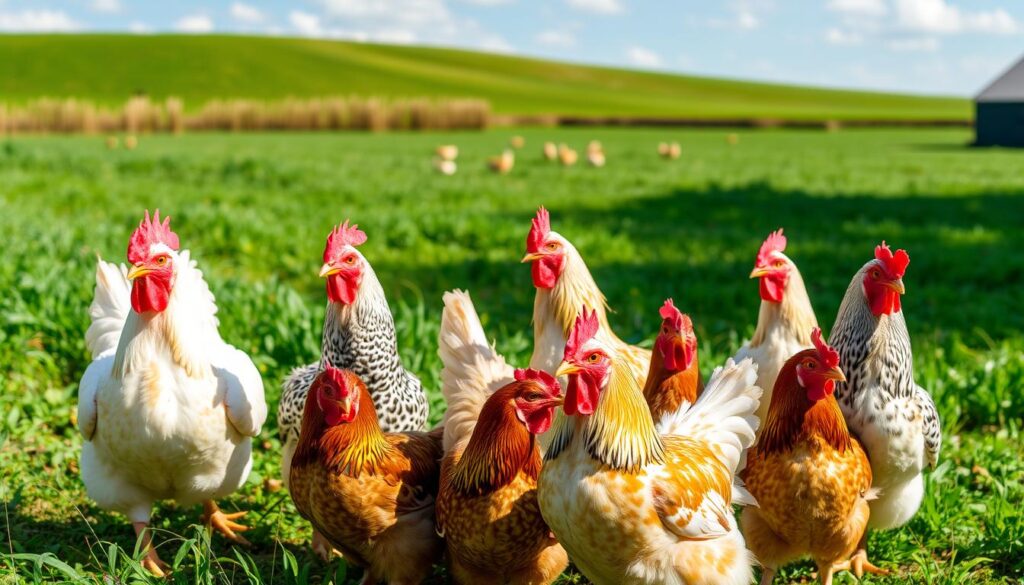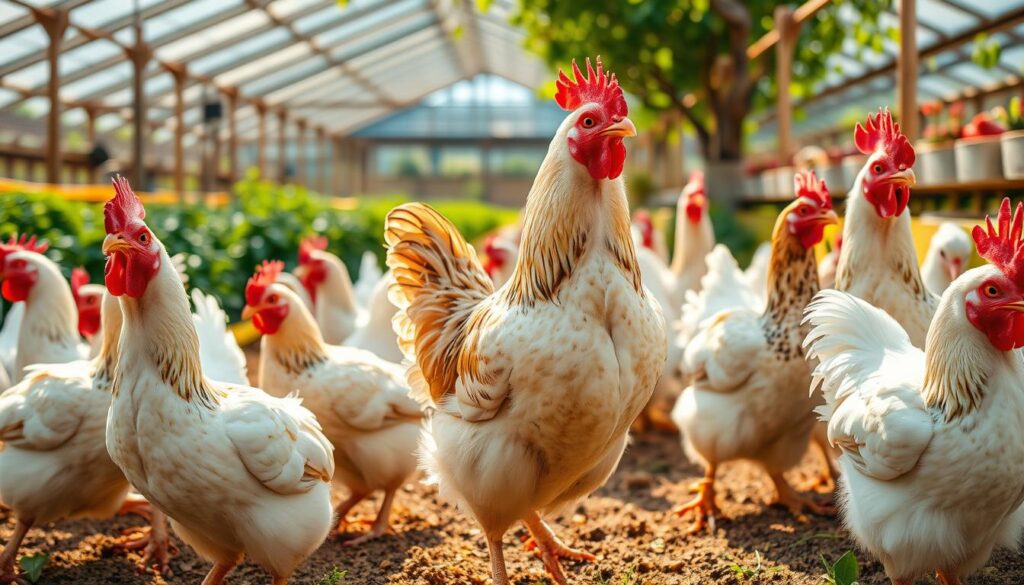
In the world of poultry farming, crossbreeding is a key tool. It helps improve broiler chicken traits. Poultry genetics is crucial in creating special broiler chicken strains. Through selective breeding, better broiler chickens are made, with improved performance and meat production.
Crossbreeding in broiler chicken production has many benefits. It helps in faster growth, better feed use, and more meat. Breeders use crossbreeding to create top-performing commercial broiler lines.
The poultry industry keeps growing, and understanding genetics and crossbreeding is key. This article explores how crossbreeding changes the industry. It also looks at the bright future ahead.
The Role of Crossbreeding in Enhancing Broiler Chicken Traits
Crossbreeding is a key method for improving broiler chickens. It combines different breeds’ genetics. This leads to better growth, feed use, and disease fighting.
The study shows how crossbreeding boosts chicken growth. It compared various breeds and their crosses. The results show big gains in growth and feed use, making broiler production better.
One big plus of crossbreeding is keeping genetic diversity in broilers. It brings in new genes, reducing inbreeding risks. This keeps the flock healthy and strong over time.
By focusing on breeding for good traits and using crossbreeding, the poultry world has made huge strides. These methods are vital for meeting the demand for quality, efficient, and sustainable broilers.
| Trait | Parental Lines | Crossbred Offspring |
|---|---|---|
| Growth Rate | Moderate | Significantly Improved |
| Feed Conversion Ratio | Average | Enhanced Efficiency |
| Disease Resistance | Varied | Increased Robustness |
Understanding Poultry Genetics
Poultry genetics is a field that explores the genetic makeup of broiler chickens. It’s key for selective breeding to improve traits like meat yield and feed efficiency.
Genetic Diversity in Broiler Chickens
Broiler chickens show a lot of genetic diversity. This comes from generations of selective breeding. It has created special strains of broiler chickens. Knowing this diversity helps breeders make better choices for their flocks.
Selective Breeding for Desirable Traits
Selective breeding is at the heart of poultry genetics. It lets breeders focus on specific traits in broiler chickens. By choosing the right parents, they can improve the flock’s performance and efficiency. This is vital for meeting the demand for quality broiler meat.
| Trait | Importance | Selective Breeding Approach |
|---|---|---|
| Meat Yield | Crucial for meeting consumer demand and profitability | Selecting parent birds with superior muscle development and growth rates |
| Feed Efficiency | Reduces production costs and environmental impact | Identifying birds that efficiently convert feed into lean muscle mass |
| Disease Resistance | Enhances flock health and reduces the need for medications | Selecting for genetic markers associated with disease resilience |
By using Poultry Genetics, breeders can keep improving the Genetic Diversity in Broiler Chickens. They can also focus on Selective Breeding for Desirable Traits. This makes the broiler chicken industry more efficient and sustainable.
Heterosis Effect and Hybrid Vigor
The success of crossbreeding programs for broiler chickens is thanks to the heterosis effect and hybrid vigor. These phenomena happen when different genetic lines are mixed. The offspring then show better performance than the original lines.
The heterosis effect, or “hybrid vigor,” means crossbred individuals often have better traits. They grow faster, weigh more, and use feed more efficiently. This is great for the broiler chicken industry, where making more and better products is key.
The reason behind the heterosis effect is the mix of different genetics. When different lines are crossed, the offspring get the best traits from both. This mix leads to better performance in crossbred broiler chickens.
Using the heterosis effect is a main goal in broiler breeding. Breeders pick and cross different lines to make chickens that are stronger, more efficient, and productive. This is better than using just one line.
| Trait | Purebred Line A | Purebred Line B | Crossbred Offspring |
|---|---|---|---|
| Body Weight | 2.5 kg | 3.0 kg | 3.8 kg |
| Feed Conversion Ratio | 1.8 | 1.6 | 1.4 |
| Livability | 90% | 92% | 95% |
The table shows how crossbred offspring can outperform purebred lines. They have better body weight, feed use, and survival rates.

By using the heterosis effect and hybrid vigor, broiler breeders can keep improving their chickens. This ensures the chickens meet the growing demand for efficient and quality poultry products.
Commercial Broiler Lines
In the poultry industry, Commercial Broiler Lines have been key to better broiler chicken production. These lines are bred for fast growth, efficient feed use, and top-notch meat quality. Poultry experts use selective breeding and crossbreeding to create many broiler strains. Each strain has its own special traits and benefits.
Specialized Broiler Chicken Strains
The Specialized Broiler Chicken Strains show the big steps forward in poultry genetics. Some top examples are:
- Cobb-Vantress: Known for fast growth and feed efficiency, Cobb-Vantress broilers are a top pick for commercial farms.
- Hubbard: Famous for great meat quality and health, Hubbard broilers are chosen for their all-around performance.
- Aviagen: With a variety of broiler lines, Aviagen has strains that excel in growth, disease resistance, and more.
- Tyson: A leading poultry company, Tyson has focused on breeding special broiler lines to meet today’s market needs.
These special broiler chicken strains, developed through careful research, have greatly improved the commercial broiler industry’s efficiency and output.
| Broiler Line | Key Traits | Performance Advantages |
|---|---|---|
| Cobb-Vantress | Rapid growth, feed efficiency | Optimal for commercial production |
| Hubbard | Meat quality, livability | Balanced performance profile |
| Aviagen | Versatile traits, disease resistance | Adaptable to diverse production environments |
| Tyson | Tailored to market demands | Meets evolving consumer preferences |
Crossbreeding Strategies for Broilers
Crossbreeding is key in broiler chicken production. It can improve many traits. Breeders and researchers use different methods to make broiler chickens better. Let’s look at some common strategies and how they affect broiler performance.
The reciprocal cross is a popular method. It involves mating two breeds in both directions. This method finds the best mix of traits, leading to better chickens. Broiler chickens from reciprocal crosses grow faster and produce more eggs.
The rotational cross is another strategy. It cycles through different breeds to keep the gene pool diverse. This method prevents inbreeding and improves traits like feed efficiency and disease resistance.
- Terminal crosses are also common. They use special sire and dam lines to focus on key traits. This method boosts growth, meat quality, and feed efficiency.
- When planning crossbreeding, age, genotype, and sex matter. Poultry producers use these factors to improve their flocks’ performance and health.
| Crossbreeding Strategy | Key Advantages | Potential Challenges |
|---|---|---|
| Reciprocal Cross | Uncovers genetic diversity, identifies favorable trait combinations | Requires more time and resources to implement |
| Rotational Cross | Maintains genetic diversity, prevents inbreeding, improves fitness | Requires careful planning and record-keeping |
| Terminal Cross | Targeted improvement of economically important traits | Potential for reduced genetic diversity over time |
By using these crossbreeding strategies, breeders and producers can make broiler chickens better. This leads to more productive, healthier, and higher-quality flocks.
Improving Broiler Performance
Crossbreeding has greatly improved broiler chicken performance. It has led to better meat production, growth rates, and feed use. These changes have made the broiler industry more successful and profitable.
Meat Production Efficiency
Broiler producers have used crossbreeding to make meat production more efficient. They mix different broiler lines to get better feed use. This means more meat is produced from each unit of feed, making operations more cost-effective.
Growth Rate and Feed Conversion
Crossbreeding has also sped up broiler chicken growth and improved feed use. Crossbred birds grow faster and use feed more efficiently. This means they reach market weight quicker and produce more muscle from the same amount of feed.
These improvements have made crossbred broilers the top choice for commercial poultry. They help meet the world’s demand for affordable, high-quality chicken meat.

Challenges and Limitations of Crossbreeding
While crossbreeding has proven to be a valuable tool in enhancing broiler chicken traits, it also comes with its own set of challenges and limitations. Understanding these factors is crucial for optimizing the benefits of crossbreeding strategies.
One of the primary challenges in crossbreeding is ensuring genetic compatibility between the parent breeds. Incompatibility can lead to reduced fertility, hatchability, and overall performance of the offspring. Breeders must carefully select compatible lines to minimize such issues and maintain the desired genetic profile.
Additionally, crossbreeding can sometimes increase the susceptibility of broilers to certain diseases. The introduction of new genetic material can disrupt the established disease resistance mechanisms, making the birds more vulnerable to specific pathogens. Diligent monitoring and targeted disease management strategies are necessary to address this concern.
Another limitation of crossbreeding is the need for ongoing selective breeding to maintain the desired traits. The hybrid vigor, or heterosis, observed in the first generation of crossbred birds may not be sustained in subsequent generations. Breeders must continually select and breed the most desirable individuals to preserve the beneficial characteristics.
Despite these challenges and limitations, crossbreeding remains a crucial tool in the poultry industry. By understanding and addressing these factors, breeders can optimize the benefits of this breeding strategy and contribute to the continued improvement of broiler chicken performance.
The Future of Broiler Chicken Breeding
The future of broiler chicken breeding looks bright, thanks to new tech and genetic research. Genomics and artificial intelligence are changing the game. They help improve the traits of these birds.
Genomics is a big deal in the future of broiler chicken breeding. It lets us understand the genetics of these chickens. We can find genes linked to growth, feed use, and meat quality. This info helps breeders make better chickens.
Artificial intelligence (AI) and machine learning will also be key. They can sift through huge amounts of data. This helps breeders pick the best traits more accurately and efficiently.
Looking ahead, we’ll see more in crossbreeding and genetic engineering. New ways to mix genetics could make chickens more resilient. Genetic tweaks might also help with diseases or adapting to the environment.
In the end, the future of broiler chicken breeding will be shaped by tech, science, and genetics. With these advances, the industry can meet the world’s demand for quality, efficient, and sustainable chicken.
Impact on the Poultry Industry
The poultry industry has seen big changes thanks to better broiler chicken breeding. Crossbreeding has made meat production more efficient. This has led to faster growth rates and better use of feed.
These improvements have made chicken meat more available and affordable. Now, people can enjoy lean, protein-rich chicken more easily. It’s a big win for those looking for healthy food options.
The poultry industry’s profits have soared. Thanks to crossbreeding, producers can make more meat for less cost. This means they can sell chicken at lower prices, reaching more people.
This shift has made chicken a staple in American diets. The industry’s quick response to what consumers want has helped it grow. It’s a key reason why chicken is so popular today.
Research and new ideas in breeding are still changing the game. As new methods come along, the industry will keep improving. This means better, more sustainable chicken for everyone.